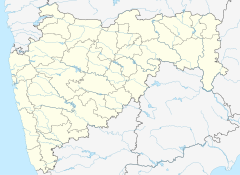Mahalakshmi Temple, Kolhapur
| Shri Mahalakshmi (Ambabai) of Kolhapur | |
|---|---|

Shri Mahalakshmi (Ambabai) Idol in the garbgruha of the shrine
|
|
|
Location in Maharashtra
|
|
| Geography | |
| Coordinates | 16°42′00″N 74°14′00″E / 16.70000°N 74.23333°ECoordinates: 16°42′00″N 74°14′00″E / 16.70000°N 74.23333°E |
| Country | India |
| State | Maharashtra |
| District | Kolhapur |
| Locale | Mahadwar Road |
| Culture | |
| Sanctum | Mahishasuramardhini /Mahalakshmi /Ambabai |
| Major festivals | Navratri |
| History | |
| Date built | 7th century |
The Shri Mahalakshmi (AmbaBai) Temple of Kolhapur in Maharashtra, India, is one of the 108 Shakti Peethas listed in various puranas of Hinduism. The temple is of special religious significance and is considered to be a place where Shakti (goddess of empowerment) manifests and as one of only six sacred houses of Shakti where worshipers can either be freed from or granted their longings.
Located on the banks of the Panchganga River, about 156 miles (252km) south of Pune, the Kolhapur Shakti Peetha takes its name from Lakshmi, the four-armed, gemstone-adorned goddess of good fortune, the universal form of whom is Shakti. Lakshmi is endowed with six divine qualities, among them prosperity (spiritual and material). It is believed that the divine couple, Lakshmi and Vishnu reside in the area.
Mounted on a stone platform, the murti of the crowned Goddess is made of gemstone and weighs about 40 kilograms. The image of Mahalakshmi carved in black stone is 3 feet in height. The Shri Yantra is carved on one of the walls in the temple. A stone lion (the vahana of the goddess), stands behind the statue. The crown contains an image of the Sheshnag, the serpent of Vishnu.
In her four hands, the deity of Mahalakshmi holds objects of symbolic value. The lower right hand holds a mhalunga (a citrus fruit), in the upper right, a large mace (kaumodaki) with its head touching the ground, in the upper left a shield and in the lower left, a bowl (panpatra). Unlike most Hindu sacred images, which face north or east, the deity faces West (Pashchim). There is a small open window on the western wall, through which the light of the setting sun falls on the face of the image for three days around the 21st of each March and September.
...
Wikipedia

